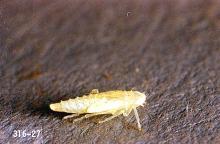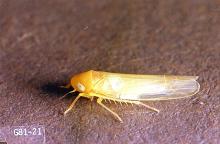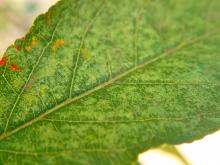Apple leafhopper (Empoasca maligna)
Rose leafhopper (Edwardsiana rosae)
White apple leafhopper (Typhlocyba pomaria)
Pest description and crop damage Multiple leafhopper species are found throughout the PNW. The most prevalent leafhopper in Washington is the white apple leafhopper, although a very similar-appearing insect, the rose leafhopper, is also present. Rose leafhopper nymphs are very similar to white apple leafhopper, but they have rows of black spots on the back. Adults and nymphs suck juices from leaves, causing stippling and mottling on leaves. Damage usually is most noticeable on neglected trees. In general, this pest is a minor problem, and even high populations rarely cause yield loss.
Biology and life history These insects overwinter as eggs just beneath the bark on 1- to 5-year-old twigs in the trees. Presence of the eggs is indicated by characteristic crescent-shape swellings in the bark. Eggs hatch around the tight cluster stage (late March to mid-April), and nymphs feed for several weeks. Adults are flying by late May and can be observed from then until frost, when they are killed. Overwintering eggs are laid in September. There are two generations per year.
Scouting and thresholds As a minor pest, monitoring is not necessary, although presence of the adults can be confirmed by early morning limb taps.
Management-biological control
Parasitic wasps exert some control over leafhopper populations.
Management-chemical control: HOME USE
Petal fall spray and Spring/ Summer
Best time to control the first generation is petal fall or shortly thereafter. Apply about 10 days after full petal fall (all petals are off) or 17 to 21 days after full bloom.
- acetamiprid
- azadirachtin (neem oil)-Some formulations are OMRI-listed for organic use.
- carbaryl-Highly toxic to bees.
- gamma-cyhalothrin-Highly toxic to bees.
- horticultural mineral oil-Some formulations are OMRI-listed for organic use.
- imidacloprid-Soil drenches may have residual activity in woody plants lasting for 12 or more months. If short-term management is the goal, consider other approaches. Highly toxic to bees.
- insecticidal soap-Some formulations OMRI-listed for organic use.
- kaolin-Applied as a spray to leaves, stems, and fruit, it acts as a repellant to target pests. Some formulations are OMRI-listed for organic use.
- lambda-cyhalothrin-Highly toxic to bees.
- malathion-Highly toxic to bees.
- permethrin-Highly toxic to bees.
- pyrethrins (often as a mix with other ingredients) -Highly toxic to bees. Some formulations are OMRI-listed for organic use.
- zeta-cypermethrin-Highly toxic to bees.
Management-chemical control: COMMERCIAL USE
Petal fall spray
- acetamiprid (Assail 70WP) at 1.1 to 1.7 oz/A in up to 100 gal water per application. Do not make more than four applications per year or exceed 13.5 oz/A per growing season. REI 12 hr. PHI 7 days. [Group 4A]
- buprofezin (Centaur WDG) at 34.5 oz/A as a ground application using a minimum of 20 gallons of water per acre. Do not make more than one application per growing season. REI 12 hr. PHI 14 days. [Group 16]
- fenpyroximate (Fujimite 5SC) at 2 pints/A in a minimum of 100 gal water per acre. Only one application per season. Do not apply through any type of irrigation system. Do not apply by alternate row middle spray method. REI 12 hr. PHI 14 days. [Group 21A]
- imidacloprid (Prey 1.6F) at 4 to 8 fl oz/A in up to 100 gal water per application. Do not use within 10 days prior to bloom or when bees are actively foraging. Allow 10 days between applications. Do not apply more than 40 fl oz/A per growing season. REI 12 hr. PHI 7 days. [Group 4A]
- insecticidal soap (M-Pede) at 1 gal/100 gal water (up to 4 gal/A in 400 gal water per acre per application). REI 12 hr. PHI 0 day. M-Pede can be phytotoxic. Some formulations are OMRI-listed for organic use.
- kaolin (Surround WP) at 25 to 50 lb/A applied as a spray to leaves, stems, and fruit. Continue applications every 7 to 14 days to assure adequate coverage on newly growing plant surfaces. Kaolin acts as a repellant to target pests. REI 4 hr. PHI 0 days.
- novaluron (Rimon) at 20 to 50 fl oz/A in 100 gal water per application. Do not use Rimon in alternate row middle application patterns since this method will result in off-timing application and poor performance. Do not apply more than 150 fl oz/A per growing season. Do not allow Rimon to drift on grapes as leaf spotting may occur. REI 12 hr. PHI 14 days. [Group 15]
- thiamethoxam (Actara WDG) at 2 to 2.75 oz/A in up to 100 gal water per application. Do not exceed 16.5 oz/A per season. Actara is extremely toxic to bees. REI 12 hr. At rates less than 2.75 oz/A, the PHI is 14 days. [Group 4A]
Spring and summer
- acetamiprid (Assail 70WP) at 1.1 to 1.7 oz/A in up to 100 gal water per application. Do not make more than four applications per year or exceed 13.5 oz/A per growing season. REI 12 hr. PHI 7 days. [Group 4A]
- clothianidin (Belay) at 4 to 6 fl oz/A in up to 100 gal water per application. Do not apply more than 12 fl oz/A per growing season. REI 12 hr. PHI 7 days. [Group 4A]
- cyantraniliprole (Exirel) at 10 to 17 fl oz/A in up to 100 gal water per application. REI 12 hr. PHI 3 days. [Group 28]
- imidacloprid (Admire Pro) at 7 to 10.5 fl oz/A in up to 100 gal water per application as a soil application. Do not apply prior to bloom or when bees are actively foraging. Do not apply more than 10.5 fl oz product/A per growing season. REI 12 hr. PHI 21 days. [Group 4A]
- indoxacarb (Avaunt) at 5.0 to 6.0 oz/A in up to 100 gal water per application. Make no more than 3 applications prior to hand-thinning. No hand thinning after the 4th application. Make no more than 4 applications per growing season. Do not apply more than 24 oz product per acre per growing season. REI 12 hr. PHI 14 days. [Group 22A]
- insecticidal soap (M-Pede) at 1 gal/100 gal water (up to 4 gal/A in 400 gal water per acre per application). REI 12 hr. PHI 0 day. Some formulations are OMRI-listed for organic use.
- kaolin (Surround WP) at 25 to 50 lb/A applied as a spray to leaves, stems, and fruit. Continue applications every 7 to 14 days to assure adequate coverage on newly growing plant surfaces. Kaolin acts as a repellant to target pests. REI 4 hrs. PHI 0 days. Some formulations are OMRI-listed for organic use.
- sulfoxaflor (Transform WG) at 0.75 to 1.5 oz/A in up to 100 gal water per application. See supplemental label. No more than four applications per season. PHI 7 days [Group 4C]
- thiamethoxam (Actara WDG) 2 to 2.75 oz/A in up to 100 gal water per application. Do not exceed 16.5 oz /A per season. Actara is extremely toxic to bees. REI 12 hr. At rates less than 2.75 oz/A, the PHI is 14 days. [Group 4A]
- thiamethoxam/chlorantraniliprole (Voliam Flexi) at 4 to 7 oz/A in up to 100 gal water per application. Do not apply exceed 16 oz of product/A per season and do not use an adjuvant within 60 days of harvest. REI 12 hr. PHI 35 days. [Group 4A & 28]





